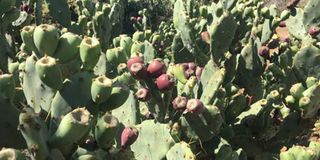Scientists find insect to curb destructive cactus plant

Opuntia ficus, an invasive cactus plant. The cactus species that is native to the Americas has proven to be a thorn in the flesh for cattle keepers. PHOTO | FILE | NATION MEDIA GROUP
What you need to know:
- It was imported and planted by British colonial officials around their outpost in the tiny town of Dol Dol in the late 1940s to early 50s.
- The cactus species that is native to the Americas has proven to be a thorn in the flesh for cattle keepers.
- Physical and chemical control of cacti is expensive and often ineffective. But scientists have identified a tiny insect, named cochineal, which can help fight the prickly pear.
- The male usually dies after mating and fertilising the female’s eggs. These eggs, once laid, are attached to her body until she dies.
An obnoxious weed has been spreading like wildfire in Laikipia County, affecting cattle production.
The erect prickly pear, as it is commonly known, or scientifically dactylopius opuntiae ‘stricta’, has become predominant across the rolling hills of the wildlife-rich county.
It was imported and planted by British colonial officials around their outpost in the tiny town of Dol Dol in the late 1940s to early 50s.
The cactus species that is native to the Americas has proven to be a thorn in the flesh for cattle keepers.
Over the years, it has invaded large swathes across the expansive grasslands, spreading to other areas including the Tsavo East National Park and the adjacent rangelands, where it forms dense stands overtaking native plant populations and preventing access to water resources and pasture. The invasive species now in Kenya is the most problematic.
Physical and chemical control of cacti is expensive and often ineffective. But scientists have identified a tiny insect, named cochineal, which can help fight the prickly pear.
“Dactylopius opuntiae 'stricta' biotype cochineal is more effective as a sustainable bio-control in the fight against the invasive common pest pear Opuntia stricta in Laikipia County, Kenya, compared to physical and/or chemical control,” a group of scientists from the Centre for Agriculture and Bioscience International (Cabi) say.
Cochineal are soft-bodied, flat and oval-shaped insects that are used to make food colours.
The females, wingless and about 5mm long, attach themselves onto cactus pads in colonies, penetrate the cacti plant, especially the prickly pear with their beak-like mouth parts and feed on its juices, remaining immobile unless alarmed.
BIOLOGICAL CONTROL
The male usually dies after mating and fertilising the female’s eggs. These eggs, once laid, are attached to her body until she dies.
The nymphs then hatch and begin the moulting and feeding process.
Female nymphs remain in one place after their first moult while the juveniles secrete protective waxy filaments that are picked up by wind and dispersed onto other host prickly pears, where they continue the process of feeding and mating, thus forming a cycle that is important in the fight against the wild plant.
Five species of cochineal insects have been used successfully in biological control of several cactus weeds around the world.
Activities to control the invasion in Laikipia were initiated in 2010 after permission was granted by the Kenya Plant Health Inspectorate Services and the National Environment Management Authority.
The cochineal insects were subsequently mass-reared and released at a number of localities on Ol Jogi Wildlife Conservancy in Laikipia in 2014.
In a preliminary survey, lead researcher Dr Arne Witt, and collaborators Winnie Nunda, Fernadis Makale and Kathryn Reynolds, said they had found that the insect from which the natural dye carmine is derived, was very effective in devouring and reducing the fruiting of the cactus plant.
“The research to determine the impact of the cochineal revealed that it had contributed to a significant reduction in the number of shoots (cladodes), flowers and fruits of plants with cochineal,” said a report by the scientists published in BioControl journal.
“Fruits that were produced on plants with the cochineal were also smaller and had fewer seeds,” it added.
“Many of the plants with cochineal had collapsed. The number of cladodes was reduced by approximately 80 per cent within a few years after release of the cochineal... Opuntia fruit production was also significantly reduced with 79 and 81 per cent of O. stricta plants in the site, with cochineal having no immature or mature fruits.”
“Although the impact of cochineal is still fairly localised, we are confident that it will establish in much of the invaded range and reduce the impact of the invasive cactus, consequently improving rangeland condition and livelihoods,” said lead researcher Dr Arne Witt, who is based at Cabi’s centre in Nairobi.





